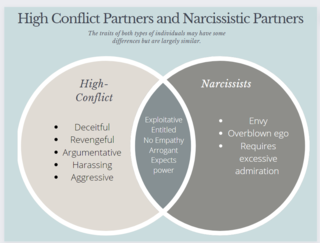Divorce
Divorcing the Narcissist in Family Court
High-conflict divorce manipulates the legal system and causes intense damage.
Posted January 5, 2022 Reviewed by Jessica Schrader
Key points
- Narcissists may engage in any means necessary to prolong conflict in a divorce.
- High-conflict divorces tend to be lengthier, more complex, and more expensive than amicable ones.
- High-conflict divorces take up an estimated 90% of family court time and resources.

Almost no one enters into marriage with the intention of divorcing. Although the divorce rate has slowed, marriage trends also continue to decline.
A high-conflict divorce is one that causes an “unquestionably destructive” emotional toll on a family unit and is described as detrimental to all members of the family (Joyce, 2016, pg. 642). This type of divorce includes hallmarks such as lack of trust, high levels of anger, and refusal to collaborate, compromise, or communicate (Joyce, 2016). It often results in lengthy and expensive litigation, causing additional tension and financial stress as well as higher levels of depression and anxiety in both the parents and the children (Hald et al., 2020).
A divorce from a narcissist will almost certainly become high conflict as the hallmarks of a high-conflict spouse are eerily similar to the traits of a narcissist. This doesn’t mean that every narcissistic breakup will be high conflict. Some types of narcissists, such as covert narcissists, are very reluctant to engage in aggressive, head-on conflict. However, they may engage in more quiet methods of attack, such as spreading rumors, or hide behind an overly aggressive legal team and play the part of the innocent victim. These toxic behaviors are designed to wear you out, break you down, and get you to just give in to their demands.
When children are involved in a divorce, the process of uncoupling is more complicated. Not only do the parents have to decide on separation of assets, but now child support, visitation, and juggling of holiday schedules come into play. When you have been married to—and now divorcing—a narcissist, the stakes become much higher. The most unfortunate aspect of a narcissistic divorce is that the children often become pawns and collateral.
A narcissist will usually not just walk away without feeling like they have won something or hurt you in some way and if that means using the children, so be it. Children suffer the most in divorces, and high-conflict divorces complicate matters further. High-conflict divorce has long been defined as that which features verbal and physical aggression, overt hostility, and distrust (Johnston, 1994). These divorces are lengthy, more complex, and far more expensive than amicable divorces (Hald et al., 2020). Sadly, an estimated 10 to 25% of children may be exposed to this trauma (Haddad et al., 2016).

More distressingly, the negative effect of high-conflict divorces on the children of the union including emotional distress, fractured relations with the parents, and emotional disturbances have been well-documented for decades (Dalton et al., 2009; Johnston, 1994; Sarkis, 2016; Visser et al., 2017). Exposure to high-conflict divorce is considered an adverse childhood event with lingering psychological effects (Haddad et al., 2016). In some arguments, high-conflict divorce is a form of child neglect (Joyce, 2016).
Above all, it is nearly impossible for a narcissist to accept blame. No matter what they may have done—cheated on a partner, broke the law, emptied the bank account—it was always done in response to an offense by someone else. They may continue dragging out the divorce, regardless of how it is damaging the other party or even the children. They may paint a pitiful story of themselves as a poverty-stricken single parent, struggling to keep their head above water, while silently pummeling the other party through harassment, character assassination, or withholding time with children. They may go as far as hiding assets from the court. If a narcissist identifies something the divorcing partner cherishes, whether a boat or child visitation, they may do everything they can to interfere and ruin your happiness.

A survivor of a high-conflict divorce, Jennifer describes her experience as a “never-ending battle” that affected “every aspect” of her life. “The court system will not help you through a high-conflict divorce. They perpetuate it,” she says. “The divorces are money-makers for all involved. This will not change until the system crashes and is rebuilt with growth and child-focus at its heart” (in Hochenberger, 2022). Indeed, a 2016 literature review of high-conflict divorces found that family courts are neither equipped nor educated to make the best decisions for custody and support (Haddad et al.). Family courts are often understaffed, undereducated, and harbor insufficient resources for handling such conflict (Haddad et al., 2016). Disturbingly, high-conflict divorces take up an estimated 90% of family court time and resources (Haddad et al., 2016; Hald et al., 2020). Twenty articles reviewed by Haddad, Phillips, and Bone in 2016 called for a need to reform the current family court system (in Hochenberger, 2022).
Narcissists can be masters at manipulation and frequently slip through the cracks of the legal system. They often do not prioritize the comfort of their children or the future of their ex; instead, they are concerned with destruction and turmoil. The welfare of the children should always be of paramount concern, not the preferences and comfort of the warring parents.
References
Joyce, A. N. (2016). High conflict divorce: A form of child neglect. Family Court Review 54(4), 642-656. https://doi.org/10.1111/fcre.12249
Haddad, L., Phillips, K. D., & Bone, J. M. (2016). High-conflict divorce: A review of the literature. American Journal of Family Law, 29(4), 243-258.
Hald, G. M., Strizzi, J. M., Cipric, A., & Sander, S. (2020). The divorce conflict scale. Journal of Divorce & Remarriage, 61(2), 83-104. http://dx.doi.org/10.1080/10502556.2019.1627150
Johnston, J. R. (1994). High-conflict divorce. The Future of Children, 4(1), 165–182. https://doi.org/10.2307/1602483
Hochenberger, K. L. D. (2022). A generic qualitative inquiry into posttraumatic growth in divorced single mothers. [Unpublished doctoral dissertation]. Capella University.


